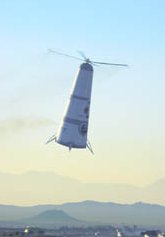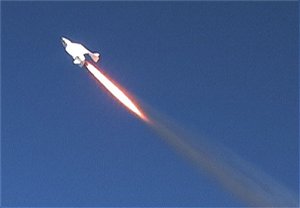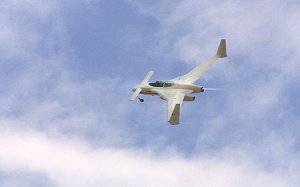|
Rocket
clubs and other non-governmental organizations and
individuals in the pre-WW II period led the development
of rocketry.
Rocket
mail - Various efforts to use rockets for
fast delivery of mail took place during the pre-war
period but never came to practical routine use. Probably
the last attempt to develop a rocket mail system was
a test
for the US Post Office in 1959.
Alex
MacDonald has written about the significant funding
of telescope observatories and scientific expeditions
by private individuals in the 1800s and early 1900s.
The Lick Observatory, for example, in 1876 was given
the equivalent of $1,220,000,000 in today's dollars.
James Lick was the richest man in California and
the Lick Observatory expenditure represented 17.5%
of his entire estate. The equivalent share o f the
wealth of the richest man in California today, Larry
Ellison, is $3.9 billion dollars, approximately four
times higher than the GDP equivalent share.
See these resources:
|
|
Based primarily within the amateur radio community,
the AMSAT
program began not long after Sputnik reached orbit.
AMSAT quickly made major contributions to the development
of communications satellites and continues to do so
today. The AMSAT projects have led the movement to prove
that small satellites can carry out very useful and
important tasks.
See the Satellite
Building and the Space
Radio sections for resources dealing with both AMSAT
and student satellite programs.
|
|
A group called the Committee for the Future,
which included a number of notables such as the futurist
Barbara Marx Hubbard, developed a plan to buy two Saturn
vehicles to fly to the Moon. The project would be paid
for out of the sale of lunar materials and media rights.
(See Greg Klerkx's book Lost in Space (2004,
Amazon: US
UK)
for more info about this and other private space ventures.)
Truax developed his first rockets in the 1930s and continued
working in rocketry up into this decade. He led several
missile programs in the Navy and Air Force until he
retired in 1959. He then formed Truax Engineering and
worked in a number of space and missile programs in
the 1960s.
He was always keen on developing low cost access to
space and came up with many designs to achieve that.
He particularly focused on sea launched systems such
as the Sea Dragon and Excalibur.
He obtained general public attention when he built
the steam rocket that powered the X-1
Skycycle for daredevil Evel
Knievel's famoust jump over the Snake River Canyon.
During the 1970s he developed probably the first serious
design for a suborbital space tourist vehicle. Called
the VolksRocket X-3, it would take one person
to 50 miles altitude using four 1000 pound thrust surplus
vernier engines used on Atlas rockets. However, his
Project Private Enterprise was never able to
raise the million dollars needed to build the VolksRocket.
See:
Further information about Truax:
This controversial German project was one of the first
purely private rocket development programs. Unfortunately,
it got caught up in Cold War politics and its own bad
choices for partners (e.g. the final partner was Libya).
The project was started in 1975 by the German aerospace
engineer Lutz Kayser who developed an innovative modular
design that would allow an multi-stage orbital rocket
to be built up from clusters of very low cost rockets.
See the links below for details of the project's history.
Though the project eventually collapsed due to political
pressures on it, the design concept still draws interest,
e.g. John Carmack of Armadillo Aerospace has
indicated that his modular approach to suborbital
and orbital vehicles was inspired by Otrag.
In 1978 a group investigated the possibility of buying
a fifth Shuttle and operating it with a consortium similar
to the original COMSAT.
[Under construction...]
See
|
|
Spacehab was the first company to create a commercial
business based just on human spaceflight. The firm raised
private money to fund development and construction of
cargo modules for the Space Shuttle. Founded in 1984,
it finally got a contract with NASA for use of its modules
on Shuttle flights in 1990. They have also been used
to support the Shuttle/Mir and ISS programs.
The company expected also to rent out its modules to
pharmaceutical and other companies for carrying out
micro-gravity experiments on the Shuttle for development
of commercial products. But the incredibly high launch
prices plus the enormous mountains of NASA red tape
and long delays between flight opportunities wiped out
commercial interest in their service. (And interest,
in fact, did exist, and still does, for such research
in space.) So NASA became Spacehab's only customer.
This proposed min-space station was designed by the
famous spacecraft engineer Max
Faget, who designed most of the early US crew capsules
during the Moon Race. He had left NASA and formed his
own company called Space Industries Inc. in 1982. The
ISF would be tended by the Space Shuttle and left unmanned
while experiments of various sorts would run autonomously.
The ISF history is rather tortured (see the long article
by Lindross). It's inital prospects for leasing space
to private companies became less and less tenable as
the limitations of the Shuttles became clear. Furthermore,
after the Space Station project began at NASA, the agency
began to see the ISF as a threat to that project and
helped to undermine support for the ISF.
This company has accomplished the remarkable task of
becoming a significant player in the mainstream space
industry during a period when space spending was flat
and when many traditional aerospace companies were disappearing
via mergers and acquisitions.
See the following links for more about the history
of the company and the development of the Pegasus launcher.
The Pegasus is an air-launched and solid-fueled vehicle
and was the first orbital rocket system to be developed
completely with private funding. (DARPA contracted Orbital
for Pegasus launches but did not provide it with development
funding. The SpaceX Falcon 1 will be the first liquid-fueled
rocket developed with private funding.)
Space Services, Inc was a small firm headed by former
astronaut Deke Slayton that tried to develop commercial
spaceflight projects such as the Percheron.
A project in 1981 to develop a low cost launcher. Space
Services, Inc. funded the building of a prototype vehicle
by GCH, Inc. a company led by Gary C. Hudson. A flight
test failed and a lack of capital prevented further
development.
A project in the early 1980s by Space Services Inc (Deke
Slayton's company). On Sept, 9, 1982, they carried out
the first launch of a privately financed rocket to reach
space with the suborbital launch of the Conestoga I.
There were two successful suborbital launches in all
but the company eventually failed due to a lack of capital.
|
|

Rotary Rocket's Atmospheric Test Vehicle (ATV)
in flight over Mojave Airport
|
|
The 1990s became an exciting period for private space
development because it seemed that there would finally
emerge a substantial market on which commercial space
transport companies could build their businesses. Several
large projects were initiated with the goal of placing
large constellations of satellites into low earth orbit
to provide mobile phone and internet communications
services to the entire world.
Teledesic planned a constellation of several hundred
satellites that would give high speed broadband service
to users everywhere. Motorola's Iridium and Loral's
Globalstar planned to offer satellite links directly
to hand-held mobile phones throughout the world.
Simply providing a replacement launch service for faulty
or obsolete satellites in these constellations was expected
to support at least two or three launch companies. Several
launch companies formed (several of which are listed
below) to pursue this market.
Unfortunately, by the time that Iridium and Globalstar
got into orbit in the late 1990s, terrestrial cell phone
services had already spread to most developed countries
and the resulting economies of scale had produced quite
low prices. The satphone systems had been designed early
in the 1990s and had several shortcomings: the phones
were large and heavy, the usage prices were very high,
and they could not be used indoors easily. (Subsequently,
the companies were reorganized as private firms and
are succeeding at providing niche services for emergency
communications, access to remote locations, aviation
communications, etc.)
Teledesic never even got a satellite into orbit. Support
for the project evaporated as its costs escalated and
faith by investors in the LEO constellation approach
was undercut by the satphone constellation failures.
The project was eventually abondoned.
When these LEO constellations failed, most of the startup
launch companies either disappeared or shifted towards
other markets such as NASA launch services and suborbital
space tourism.
Civilian Astronauts Corps in 1997 - the organizers
of this project tried to raise money via $2000 contributions
from the public who would obtain the opportunity of
later flying on the Advent vehicle. However, the firm
could not reach a sum sufficient to develop the vehicle
and so all of the money collected was returned to contributers.
An ambitious private expendable launch vehicle project
started in the 1990s by Texas billionaire Andrew Beale.
In March 2000, the company test fired the BA-810
hydrogen peroxide/kerosene engine, which was the
largest liquid fueled rocket engine developed in the
US since the Apollo program. However, later that year
Beale closed the company, claiming that it was not possible
for a purely private launcher to compete with military
and NASA funded programs such as the EELVs.
The K-1 is a fully reusable two-stage orbital launcher.
It was designed to server the LEO constellation market
of the 1990s. After the failure of that market the company
had to suspend development of the vehicle while looking
for further funding. Several times it seemed that NASA
would provide it with contracts that would allow it
to raise funding but these were either insufficient
or fell through. (SpaceX successfully challenged one
contract that had been awarded in a sole source manner.)
Eventually the company went into bankruptcy having spent
$800M while having raised only $600M.
Kistler Aerospace came out of bankruptcy after successfully
re-negotiating its debts but it still had trouble raising
funding to get its vehicle development back on track.
In March 2006, Rocketplane bought Kistler and in August
of 2006 the Rocketplane-Kistler won an agreement with
NASA under the COTS program to demonstrate the capability
to provide cargo resupply services to the ISS. Unfortunately,
Rocketplane-Kistler was unable to raise the required
matching funds from private investors and the COTS agreement
was canceled in late 2007.
See the following links for further info
See the Rotary
Rocket links and the interview with Gary
Hudson.
Founded by the late Jim Benson, the company Initially
pursued a commercial asteroid prospector mission. However,
experiments that were proposed to by carried on the
spacecraft were not approved by NASA and the project
eventually was abandoned (see Rex Ridenoure's Space
Review history of the project). Eventually, SpaceDev
developed into a smallsat builder and a hybrid rocket
motor firm (Benson obtained the IP of the AMROC
company). SpaceDev provided the SpaceShipOne hybrid
motor.
Benson left the firm in 2006 to form BensonSpace to
build suborbital space vehicles, including the Dream
Chaser, in partnership with SpaceDev. Unfortunately,
he died two years later of a brain tumor. SpaceDev was
soon bought by Sierra Nevada, which has developed the
Dream Chaser concept into a possible NASA Commercial
Crew Program provider of transportation to the ISS.
A spinoff
of the AMSAT/student satellite program at the University
of Surrey, this firm succeeded in making a commercial
business from small satellites.
This company, co-founded by Pete Conrad, offers low
cost ground station support for satellite control and
telemetry services.
This company carried out a serious effort to privatise
the Russian Mir space station. They did not succeed
but did helped to set in motion the Dennis Tito flight
to the ISS and the subsequent ISS space tourism program
(though taken over by Space
Adventures). They backed the first privately financed
manned space mission when they funded a Soyuz mission
to Mir. See details about MirCrop in the NewSpace
business section and in the Space
Tourism section.
The documentay Orphans
of Apollo: The Battle of the Mir & the New Space Revolution
tells the behind the scenes story of the project.
|
|
A hugely successful competition that required private
teams to build manned rocket vehicles capable of flying
to 100km twice within two weeks. It was won in October
of 2004 by the SpaceShipOne team led by Burt Rutan.
This decade has become a boom time for suborbital spaceflight
projects. Here are some of the projects and companies:
Several of these companies are pursuing the suborbital
tourism business but scientific and reconnaissance
applications are also markets of interest.
On April 28, 2001 Dennis
Tito became the first person to pay his own way
into space. This essentially made him the first true
space tourist (as opposed to some politicians and a
journalist. Helen Sharman won her trip because she of
her science background.) The payment is often reported
as $20M but has been rumored to be as low as $12M.
Arrangements for the flight originally started with
the Mir-Corp organization but eventually switched over
to Space
Adventures. The latter company has since then arranged
for three other people to pay for such trips. (Following
the Columbia disaster, there was a long moratorium on
such visits by non-professional astronauts.)
[Under construction...]
|
|
- Jim
Benson (1945 - October 10, 2008) was a successful
computer industry entrepreneur before he founded SpaceDev
with the goal of developing low cost spacecraft. SpaceDev
also built the hybrid propulsion system for the SS1.
He later started BensonSpace to develop a suborbital
space tourism vehicle.
- Len
Cormier (1926 - June 16, 2008) began working
in the space industry in the 1950s and he devoted
much of his life to developing lower cost access to
space. See his Tour2Space
website for info on some of his projects.
- Thomas F. Rogers (1924 -Feb. 13, 2009)
|






